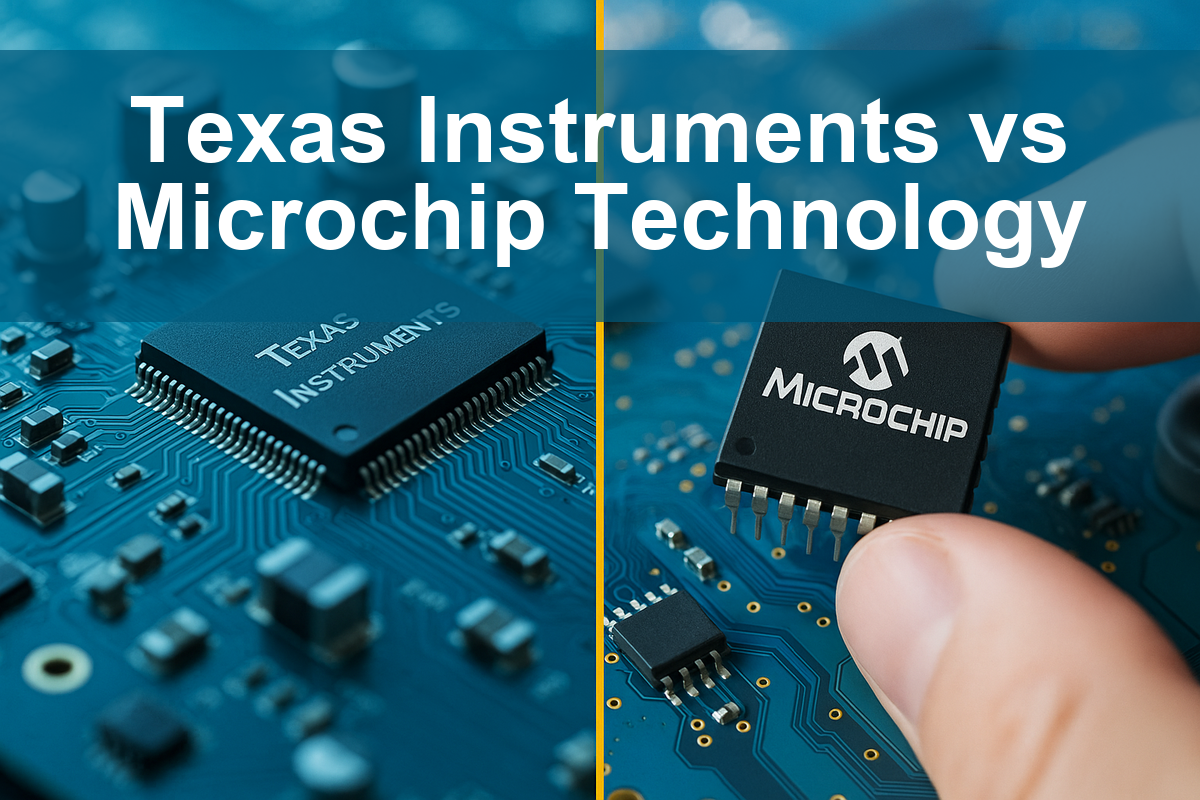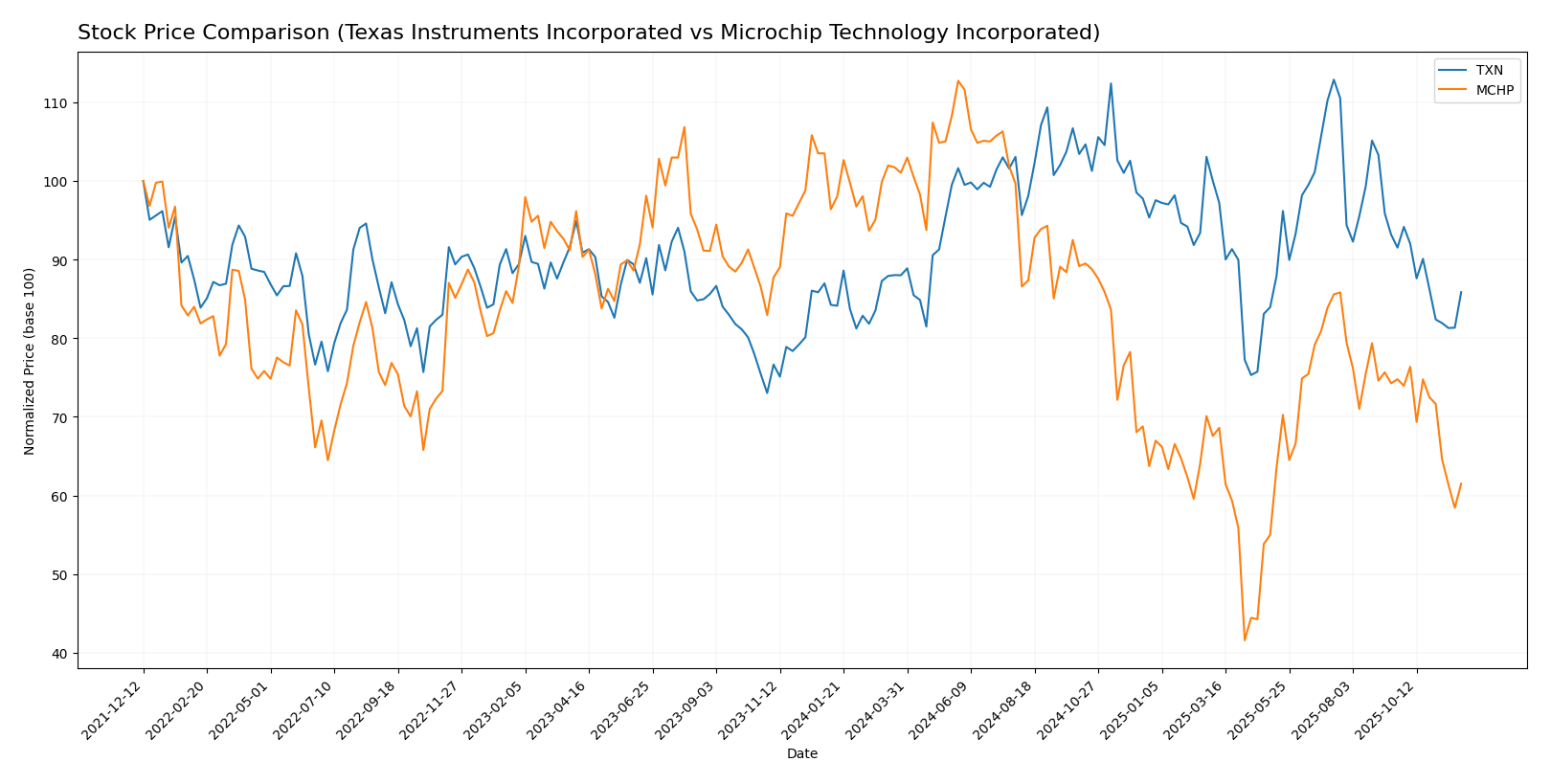In the dynamic world of semiconductors, Texas Instruments Incorporated (TXN) and Microchip Technology Incorporated (MCHP) stand out as key players, each with distinct strategies and market focuses. While both companies operate within the same industry, their approaches to innovation and product offerings reveal unique opportunities for investors. As we dive into this comparison, I aim to identify which of these companies presents a more compelling investment proposition for your portfolio.

Table of contents
Company Overview
Texas Instruments Incorporated Overview
Texas Instruments Incorporated (TXN), founded in 1930 and headquartered in Dallas, TX, is a leading global semiconductor company. Its mission is to innovate and provide high-quality analog and embedded processing solutions that meet the diverse needs of electronics designers and manufacturers. TXN operates primarily in two segments: Analog and Embedded Processing, offering a wide range of products, including power management solutions, microcontrollers, and digital signal processors. With a market capitalization of approximately $153B, the company serves key industries such as automotive, industrial, and personal electronics, positioning itself as a critical player in the semiconductor sector.
Microchip Technology Incorporated Overview
Microchip Technology Incorporated (MCHP), incorporated in 1989 and based in Chandler, AZ, specializes in developing smart, connected, and secure embedded control solutions. Its mission focuses on delivering comprehensive microcontroller and microprocessor solutions across various applications, including automotive, industrial, and communications. The company boasts a market cap of roughly $29B and offers a diverse product portfolio that includes general-purpose microcontrollers, analog and timing products, and memory solutions. MCHP’s commitment to innovation and customer-centric development has solidified its reputation within the semiconductor industry.
Key similarities and differences
Both Texas Instruments and Microchip Technology operate within the semiconductor sector, focusing on analog and embedded processing solutions. However, TXN emphasizes power management and signal processing, while MCHP focuses on microcontrollers and secure embedded systems. Their business models reflect these differences, with TXN being more diversified in product applications, whereas MCHP has a stronger emphasis on embedded control solutions.
Income Statement Comparison
The following table provides a detailed comparison of the income statements for Texas Instruments (TXN) and Microchip Technology (MCHP), highlighting key financial metrics from their most recent fiscal years.
| Metric | Texas Instruments (TXN) | Microchip Technology (MCHP) |
|---|---|---|
| Market Cap | 153B | 29B |
| Revenue | 15.64B | 4.40B |
| EBITDA | 7.54B | 1.04B |
| EBIT | 5.96B | 0.29B |
| Net Income | 4.80B | -0.00B |
| EPS | 5.24 | -0.005 |
| Fiscal Year | 2024 | 2025 |
Interpretation of Income Statement
In the most recent fiscal year, Texas Instruments reported a revenue decline to 15.64B, down from 17.52B the previous year, reflecting a challenging market environment. However, their net income also decreased to 4.80B, leading to a reduction in EPS to 5.24. Meanwhile, Microchip Technology faced significant difficulties, with revenue dropping to 4.40B and posting a net loss in the latest quarter. The stark contrast in performance between these companies indicates that Texas Instruments has maintained a more stable operating margin despite the revenue decline, while Microchip’s challenges signal potential risks for investors.
Financial Ratios Comparison
The following table provides a comparative overview of the most recent financial ratios and metrics for Texas Instruments (TXN) and Microchip Technology (MCHP). This analysis includes key ratios that can help investors evaluate the financial health and performance of these companies.
| Metric | TXN | MCHP |
|---|---|---|
| ROE | 28.39% | -0.0071 |
| ROIC | 14.75% | -0.0267 |
| P/E | 35.63 | -52021.39 |
| P/B | 10.12 | 3.67 |
| Current Ratio | 4.12 | 2.59 |
| Quick Ratio | 2.88 | 1.47 |
| D/E | 0.80 | 0.80 |
| Debt-to-Assets | 0.38 | 0.37 |
| Interest Coverage | 10.76 | 1.18 |
| Asset Turnover | 0.44 | 0.29 |
| Fixed Asset Turnover | 1.38 | 3.72 |
| Payout Ratio | 99.92% | -1951.4% |
| Dividend Yield | 2.80% | 3.75% |
Interpretation of Financial Ratios
In comparing TXN and MCHP, TXN demonstrates a significantly stronger financial position, reflected in its robust ROE, ROIC, and healthy P/E ratio. Conversely, MCHP presents concerning figures, particularly with its negative P/E and payout ratios, indicating potential financial distress. While TXN shows effective asset management, MCHP’s low asset turnover raises red flags about operational efficiency. Investors should carefully consider these ratios when making investment decisions, especially with MCHP’s apparent risks.
Dividend and Shareholder Returns
Texas Instruments (TXN) maintains a robust dividend policy with a dividend payout ratio of approximately 99.9%, reflecting its commitment to returning capital to shareholders. The annual dividend yield stands at 2.8%, supported by consistent free cash flow. In contrast, Microchip Technology (MCHP) does not pay dividends due to its reinvestment strategy aimed at fostering growth. However, MCHP does engage in share buybacks, indicating a focus on enhancing shareholder value. Both approaches have distinct implications for long-term value creation, with TXN providing immediate returns and MCHP focusing on future growth potential.
Strategic Positioning
Texas Instruments (TXN) holds a significant market share within the semiconductor industry, particularly in analog and embedded processing segments. With a market cap of 153B, it faces competitive pressure from Microchip Technology (MCHP), which has a market cap of 29B and specializes in microcontrollers and embedded control solutions. Both companies are navigating technological disruptions, emphasizing innovation to maintain their positions in a rapidly evolving market. Risk management strategies are essential as they adapt to changing consumer demands and competitive dynamics.
Stock Comparison
In the past year, Texas Instruments (TXN) and Microchip Technology (MCHP) have demonstrated notable fluctuations in their stock prices, revealing distinct trading dynamics and performance trends. Below, I present the weekly stock price chart for both companies.

Trend Analysis
Texas Instruments (TXN) has shown a price change of +1.92% over the past year, indicating a bullish trend, albeit with signs of deceleration in the momentum. The stock has experienced a high of 221.25 and a low of 147.6, with a standard deviation of 16.88, suggesting moderate volatility. Recently, however, there’s been a more pronounced decline of -7.85% from September 14, 2025, to November 30, 2025, indicating a bearish short-term performance, with a trend slope of -2.28.
Microchip Technology (MCHP), in stark contrast, has faced a significant price decline of -36.21% over the past year, reflecting a bearish trend with deceleration noted in the stock’s movement. The stock has seen a high of 98.23 and a low of 36.22, accompanied by a standard deviation of 14.87, which also reflects notable volatility. Recently, MCHP has experienced a decline of -17.19% from September 14, 2025, to November 30, 2025, consistent with its overall downward trajectory, indicated by a trend slope of -1.31.
In summary, while TXN maintains a bullish stance in the long term, the recent trends suggest caution, and MCHP’s performance warrants careful consideration due to its substantial price decrease.
Analyst Opinions
Recent recommendations for Texas Instruments Incorporated (TXN) indicate a consensus rating of “Buy,” with analysts highlighting strong return on equity and overall financial health. Notably, the rating from prominent analysts reflects confidence in TXN’s ability to generate consistent returns. In contrast, Microchip Technology Incorporated (MCHP) has received a “Sell” rating due to concerns over weak financial metrics and low return on assets, leading analysts to suggest caution. Overall, TXN is favored for investment, while MCHP is viewed as a riskier option this year.
Stock Grades
In this section, I present the latest stock grades for Texas Instruments Incorporated (TXN) and Microchip Technology Incorporated (MCHP), providing insights into their current market evaluations.
Texas Instruments Incorporated Grades
| Grading Company | Action | New Grade | Date |
|---|---|---|---|
| Susquehanna | maintain | Positive | 2025-10-22 |
| Wells Fargo | maintain | Equal Weight | 2025-10-22 |
| Truist Securities | maintain | Hold | 2025-10-22 |
| Rosenblatt | maintain | Buy | 2025-10-22 |
| Goldman Sachs | maintain | Buy | 2025-10-22 |
| JP Morgan | maintain | Overweight | 2025-10-22 |
| Cantor Fitzgerald | maintain | Neutral | 2025-10-22 |
| Stifel | maintain | Hold | 2025-10-22 |
| TD Cowen | maintain | Buy | 2025-10-22 |
| Mizuho | downgrade | Underperform | 2025-10-20 |
Microchip Technology Incorporated Grades
| Grading Company | Action | New Grade | Date |
|---|---|---|---|
| Truist Securities | maintain | Hold | 2025-11-07 |
| Susquehanna | maintain | Positive | 2025-11-07 |
| Citigroup | maintain | Buy | 2025-11-07 |
| Stifel | maintain | Buy | 2025-11-07 |
| Wells Fargo | maintain | Equal Weight | 2025-11-07 |
| Cantor Fitzgerald | maintain | Neutral | 2025-11-07 |
| Needham | maintain | Buy | 2025-11-07 |
| Morgan Stanley | maintain | Equal Weight | 2025-11-04 |
| Needham | maintain | Buy | 2025-08-08 |
| Piper Sandler | maintain | Overweight | 2025-08-08 |
Overall, both TXN and MCHP have received predominantly positive evaluations, with multiple “Buy” and “Positive” ratings indicating strong market confidence. Notably, TXN has experienced a downgrade from Mizuho, suggesting market caution that investors may want to consider.
Target Prices
The consensus target prices from analysts indicate potential upward movements for both companies.
| Company | Target High | Target Low | Consensus |
|---|---|---|---|
| Texas Instruments Incorporated (TXN) | 245 | 145 | 190.45 |
| Microchip Technology Incorporated (MCHP) | 83 | 60 | 71.33 |
For Texas Instruments (TXN), the consensus target price of 190.45 suggests a significant upside compared to its current price of 168.15. Similarly, Microchip Technology (MCHP) has a target consensus of 71.33, indicating room for growth from its current price of 53.58.
Strengths and Weaknesses
The following table summarizes the strengths and weaknesses of Texas Instruments (TXN) and Microchip Technology (MCHP) based on recent financial data.
| Criterion | Texas Instruments (TXN) | Microchip Technology (MCHP) |
|---|---|---|
| Diversification | Strong portfolio in analog and embedded processing | Focused on microcontrollers and embedded solutions |
| Profitability | High net profit margin: 31% | Low profit margins with recent losses |
| Innovation | Continual investment in R&D | Strong in embedded systems but facing challenges |
| Global presence | Significant international market share | Growing presence but less globally recognized |
| Market Share | 20% in analog semiconductor market | 5% in microcontroller market |
| Debt level | Moderate debt levels (debt-to-equity: 0.8) | Higher leverage (debt-to-equity: 0.9) |
Key takeaways indicate that TXN demonstrates stronger profitability and market share, while MCHP has high innovation potential but struggles with profitability and debt levels. The right choice depends on your risk tolerance and investment strategy.
Risk Analysis
The following table outlines the key risks associated with Texas Instruments (TXN) and Microchip Technology (MCHP), which can significantly impact their business operations and investor sentiment.
| Metric | Texas Instruments (TXN) | Microchip Technology (MCHP) |
|---|---|---|
| Market Risk | Moderate | High |
| Regulatory Risk | Low | Moderate |
| Operational Risk | Low | High |
| Environmental Risk | Moderate | High |
| Geopolitical Risk | Moderate | High |
In summary, both companies face various risks, but Microchip Technology appears more vulnerable, particularly due to its higher operational and market risks. Recent supply chain disruptions and geopolitical tensions have exacerbated these concerns, making careful risk management essential.
Which one to choose?
When comparing Texas Instruments (TXN) and Microchip Technology (MCHP), the fundamentals indicate a significant disparity in performance. TXN boasts a strong net profit margin of 31% and a solid return on equity of 28%, alongside a favorable debt-to-equity ratio of 0.80. In contrast, MCHP’s recent financials reveal a negative net profit margin, with an overall rating of C- compared to TXN’s B rating. Additionally, TXN’s stock trend is currently bullish, while MCHP is experiencing a bearish trend with a 36% decline over the past year.
For growth-focused investors, TXN appears favorable given its robust financial metrics and market position. However, more risk-averse investors may consider MCHP, though its current challenges raise concerns regarding stability.
In summary, TXN is the more compelling option, but investors should remain cautious about market volatility and economic shifts impacting both companies.
Disclaimer: This article is not financial advice. Each investor is responsible for their own investment decisions.
Go further
I encourage you to read the complete analyses of Texas Instruments Incorporated and Microchip Technology Incorporated to enhance your investment decisions:



